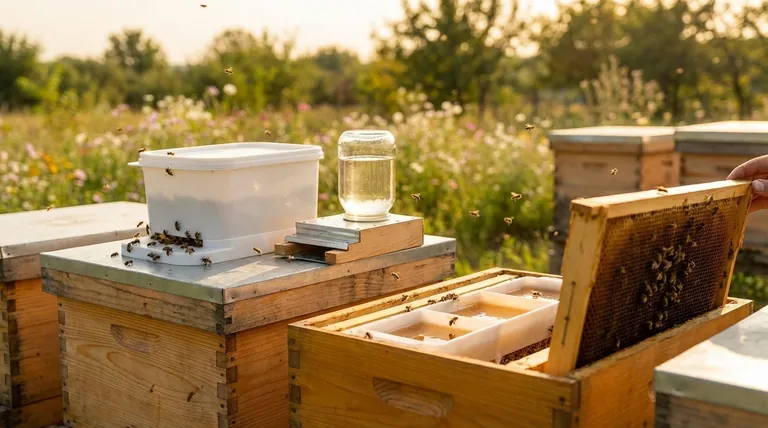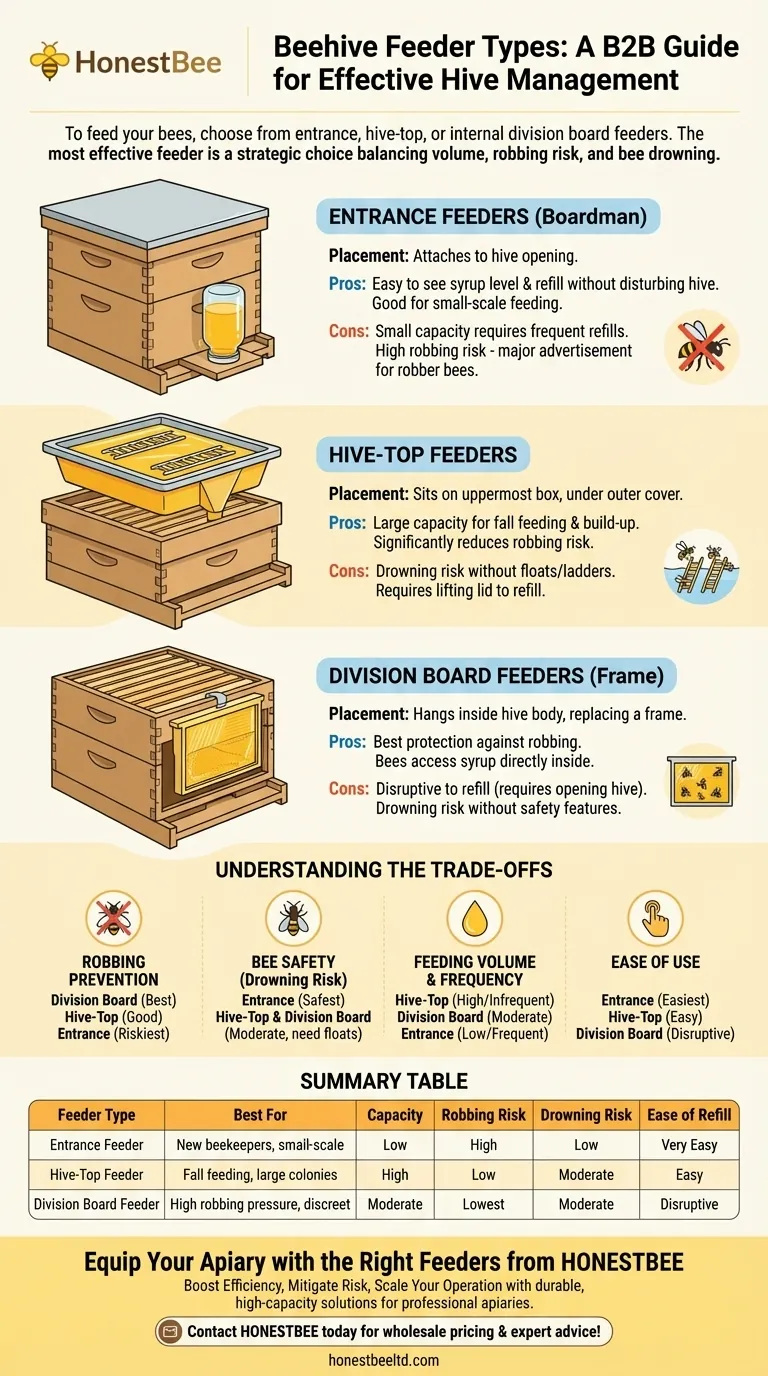To feed your bees, you have three primary options: entrance feeders, hive-top feeders, and internal division board feeders. Entrance feeders attach to the hive's opening, hive-top feeders sit on the uppermost box, and division board (or frame) feeders hang inside the hive body in place of a frame.
The most effective feeder is not a single product, but a strategic choice. Your decision must balance the volume of feed required, the risk of attracting robber bees from other colonies, and the potential for your own bees to drown.

A Closer Look at Each Feeder Type
Each feeder design offers a distinct set of advantages and disadvantages. Understanding these is the first step toward effective hive management.
Entrance Feeders
Also known as Boardman feeders, these are among the most common for new beekeepers. They consist of a small platform wedged into the hive entrance that holds an inverted jar (typically a standard Mason jar) filled with syrup.
Bees access the syrup through small holes in the jar's lid. Because the jar is clear and external, you can see how much syrup is left at a glance without disturbing the hive.
However, their small capacity requires frequent refilling, and their placement at the entrance is a major advertisement for robber bees, which can create significant problems for a weak colony.
Hive-Top Feeders
These large-capacity feeders are placed on top of the uppermost hive box, directly under the outer cover. They allow you to provide a large volume of syrup at once, making them ideal for fall feeding or stimulating a large, established colony.
One common style is a gravity feeder, often an inverted bucket or can with small holes in the lid that sits over the inner cover's central hole. Another style is a long trough with floats or ladders that prevent bees from drowning while they access the syrup.
Hive-top feeders significantly reduce the risk of robbing because the food source is contained within the hive's upper layers, away from outside pests.
Division Board Feeders
Often called frame feeders, these are thin, plastic containers designed to occupy the space of one or two frames inside the hive body. You simply remove a frame and hang the feeder in its place.
Because the feeder is entirely internal, it offers the best protection against robbing. The bees can access the syrup directly from the comb without ever leaving the hive interior.
The primary drawback is the risk of bees drowning. It is critical to use models that have built-in floats, ladders, or a textured interior surface that allows bees to maintain their footing. Refilling also requires you to open the hive completely.
Understanding the Trade-offs
Choosing a feeder is a classic exercise in weighing trade-offs. The perfect feeder for one situation may be entirely wrong for another.
Robbing Prevention
Feeding can trigger a "robbing" frenzy where stronger hives attack weaker ones to steal their resources. This is a primary concern.
Internal feeders like the division board feeder are the safest option, as they offer no external cues. Hive-top feeders are also very good at preventing robbing. Entrance feeders are the riskiest by a wide margin.
Bee Safety (Drowning Risk)
Any open container of syrup poses a drowning hazard to bees.
Entrance feeders are generally the safest in this regard. Both hive-top and division board feeders can be dangerous if they do not include features like floats, ladders, or rough-sided interiors to help bees climb out.
Feeding Volume and Frequency
Your feeding needs change throughout the season. A new, small colony needs less syrup than a large, established one preparing for winter.
For large volumes and infrequent refilling, hive-top feeders are the clear winner. Division board feeders offer a moderate capacity, while entrance feeders are best for small-volume, supplemental feeding only.
Ease of Use for the Beekeeper
Consider the labor involved. An entrance feeder is the easiest to monitor and refill. A hive-top feeder is also easy to refill but requires lifting the hive lid.
A division board feeder is the most disruptive, as it requires you to fully open the hive, break the propolis seal, and disturb the colony to check levels and refill.
Making the Right Choice for Your Goal
Select your equipment based on your specific objective for the colony at that moment.
- If your primary focus is simplicity and small-scale feeding for a new package: An entrance feeder is a simple and inexpensive way to get started.
- If your primary focus is providing large volumes of syrup with minimal robbing risk: A hive-top feeder is the most efficient and secure option for fall feeding or major build-ups.
- If your primary focus is discreet feeding in an area with high robbing pressure: A division board feeder with proper safety features keeps the food source entirely hidden from outsiders.
Understanding how each feeder functions empowers you to manage your hives with precision and care.
Summary Table:
| Feeder Type | Best For | Capacity | Robbing Risk | Drowning Risk | Ease of Refill |
|---|---|---|---|---|---|
| Entrance Feeder | New beekeepers, small-scale feeding | Low | High | Low | Very Easy |
| Hive-Top Feeder | Fall feeding, large colonies | High | Low | Moderate (with floats/ladders) | Easy |
| Division Board Feeder | High robbing pressure, discreet feeding | Moderate | Lowest | Moderate (with floats/ladders) | Disruptive |
Equip Your Apiary with the Right Feeders from HONESTBEE
Choosing the correct feeder is crucial for colony health and productivity. As a trusted wholesale supplier for commercial apiaries and beekeeping equipment distributors, HONESTBEE provides durable, high-capacity feeding solutions designed for professional beekeeping operations.
We help you:
- Boost Efficiency: Feed large colonies effectively with our high-volume hive-top and division board feeders.
- Mitigate Risk: Protect your investment with feeders designed to minimize robbing and drowning.
- Scale Your Operation: Access wholesale pricing on bulk orders of reliable equipment.
Ready to optimize your feeding strategy? Let our experts help you select the perfect equipment for your apiary's needs.
Contact HONESTBEE today for wholesale pricing and expert advice!
Visual Guide

Related Products
- Boardman Entrance Bee Feeder Durable Galvanized Steel and Wood Construction for Beekeeping
- HONESTBEE Entrance Bee Feeder Professional Hive Nutrition Solution for Beekeeping
- Professional Hive Front Entrance Bee Feeder
- HONESTBEE Professional Hive Top Bee Feeder Feeding Solution
- HONESTBEE Entrance Bee Feeder Efficient Hive Front Liquid Feeding Solution for Beekeeping
People Also Ask
- How does a bee entrance feeder work? A Simple Guide to Convenient Hive Feeding
- Are entrance feeders good for bees? Prioritize Hive Health Over Convenience
- How does an entrance feeder work? A Guide to Its Simple Mechanics and Risks
- What is an entrance feeder? A Guide to Its Simple Design and High Robbing Risk
- How does the entrance feeder method work? A Guide to Simple But Risky Hive Feeding



















